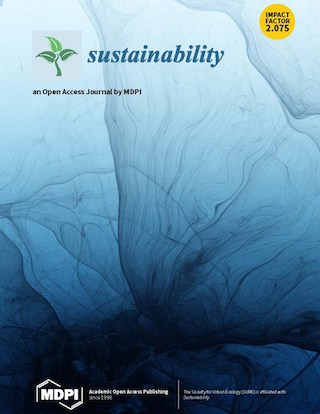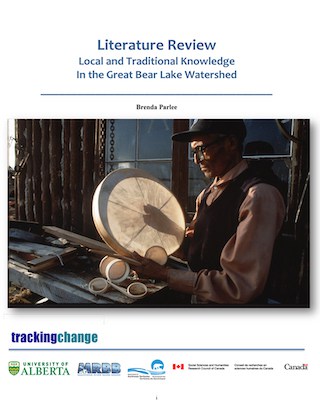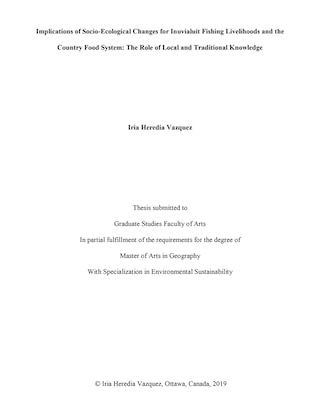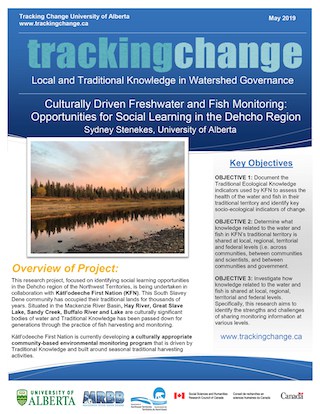Sahtú Renewable Resources Board Community Page
Ɂehdzo Got’ı̨nę Gots’ę́ Nákedı Sahtu Renewable Resource Board
P.O. Box 134
Tulita, NT
X0E 0K0
Telephone: 867-588-4040
Fax: 867-588-3324
Email: info@srrb.nt.ca
Website: www.srrb.nt.ca
Facebook: www.facebook.com/SahtuWildlife
About Our Territory
The Sahtú Region, Northwest Territories is arguably the most ecologically diverse area of North America, encompassing the world’s eighth-largest freshwater lake, Sahtú (Great Bear Lake); portions of Shúhtaot’ı̨nę Nę́nę́ (the Mackenzie Mountains) and Canada’s longest river system, Dǝho (the Mackenzie River); and the transition between dechı̨ta (taiga forest) and gokw’i (arctic tundra). The cultural and linguistic diversity of its Dene and Métis peoples arises from the region’s landscapes; families traditionally traveled seasonally on the land and today many families maintain or are seeking to rekindle their ancestral stewardship roles with specific areas.
Ɂehdzo Got’ı̨nę Gots’ę́ Nákedı
(Sahtú Renewalbe Resources Board)
The Ɂehdzo Got’ı̨nę Gots’ę́ Nákedı (Sahtú Renewable Resources Board) is the main instrument of wildlife management in the Sahtu Settlement Area and is also responsible for wildlife and harvesting, to maintain Dene and Métis harvesting traditions, and keep the land and animals healthy for future generations in and around the five communities, they are the resource management board that was created by the Sahtú land claim agreement and also is one of three co-management boards in the Sahtú Region, along with the Sahtú Land and Water Board and Sahtú Land Use Planning Board. They work with the communities, government, and industry to manage the land wisely, But mostly with the People around the main communities, Fort Good Hope, Tulı́t’a, Norman Wells, Behdzı Ahda (Colville Lake), and Délı̨nę.
The Ɂehdzo Got’ı̨nę Gots’ę́ Nákedı has also been very involved in many projects like Climate Change, Education and Training, Mapping, Monitoring, Traditional Economy and Traditional Knowledge, but also been involved in a lot of on the land programs such as Dene Ts’įlį 2017-2018, The Guardians Program in 2019, Sahtu Youth Network Gathering 2019
Image Gallery
Community Projects
2016 - Sahtú hé Deocha hé Dene Náowerǝ́ Chets’elǝ – Great Bear Lake and Mackenzie River Dene Knowledge: Research Camps
Project Leads: Leon Andrew, Sahtú Renewable Resources Board; Michael Neyelle, Sahtú Renewable Resources Board; Edward Reeves, Délın̨ ę Ɂehdzo Got’ın̨ e; Roger Odgaard, Sahtu Monitoring Forum; Jennie Vandermeer, Government of the Northwest Territories; Mandy Bayha, Délın̨ ę Ɂehdzo Got’ın̨ e; *Chelsea Martin, University of Alberta
This Project was an on-the-land camp designed by the Nę K’ǝ Dene Ts’ı̨lı̨ Forum, including an annual Sahtú cross-cultural research camp. Participants gathered in order to document narratives and a practice-based system for cross-family, cross-community, and cross-generational exchange of traditional knowledge and skills in water safety, fish preparation, and the sharing economy. The goal was to strengthen the planning processes for traditional research and provide information about water and fish, to reinforce community governance and leadership in water stewardship, and to further out collaboration with community-driven traditional knowledge research and monitoring. The elder interviewees in the project shared plenty of knowledge about fishing practices and their harvesting travels, past and present. Some of the main lessons learned include:
- Though there were fish in many places, some areas where the fish were, were not considered safe to eat due to high levels of minerals and mercury.
- Both salmon and char have been caught in recent years although they weren’t ever seen in the past.
- It was noted that fish are getting skinner.
- Water quality and health of the fish was a concern in the area that have been used by industry, but also there are five abandoned mine sites in that region, and when the companies left, they abandon equipment on the ice, when the ice melted the equipment sunk to the bottom of the lake and remains there.
- Freeze-up and break-up times are becoming unpredictable and people are unable to plan as they have in the past cause the ice is melting much earlier in the year, affecting both travel and fishing.
- There was general agreement that water levels in the region are also lower than in the past.
- Water temperature has also increased.
Further benefits are as a result of the cross-cultural research camp involved the fact that a group of youth from the five communities of the Sahtú Region held a number of youth caucus meetings at the camp to address Tracking Change themes and plan an on-the-land school-based camp for youth that would provide opportunities to learn the skills required for harvesting. The main objective of these caucus meetings was also to create a network for youth around the Sahtú which gives them opportunities to develop ideas, activities, and structures that will help them build their connections to each other and their culture their way. The youth emphasized the importance of learning from their own elders about Dene values, identity, language, and culture.
2017 - Tulit’a Got’ine Traditional Knowledge: The Impact of Climate Change on Fishing Livelihoods
Fishing is an important livelihood activity for many northern indigenous communities, especially within the Sahtu. However, ongoing climate-related changes are raising newfound concerns about the future of fishing and fishing livelihoods. In 2016, Deline Got’ine community members participated in a pilot year with the Tracking Change Project, which focused on possible environmental changes in and around the Great Bear Lake region. In 2017, research for the Tracking Change project will be organized around documenting change on the Mackenzie River from the perspective of Tulit’a Got’ine. Through hands-on activities, participants will share and interpret traditional knowledge about the changing ecology of water and fishing livelihoods on the Mackenzie River. Semi-structured interviews will be conducted by a graduate student in order to explore the climate change-related impacts on water, fish, fish health, as well as well-being.
2018 - Keeping the K’áhsho Got’ı̨nę Fishing Livelihood Strong for the Future
Written by: Deborah Simmons, Leon Andrew, Kirsten Jensen (Sahtú Renewable Resources Board), Harry Harris (Fort Good Hope Ɂehdzo Got’ı̨nę – Renewable Resources Council) and Anne Marie Jackson (Fort Good Hope)
Project Summary…
Although fish harvesting techniques have changed through colonization and amongst generations, some people still retain important practices that keep them connected to the land. Fish has always been a food staple for communities of the Sahtú region, available when other foods like caribou and moose are scarce. However, ongoing climate-related changes are raising newfound concerns about the future of fishing and fishing livelihoods and culture. Since 2016 this project has focused on environmental change in and around the Dǝhogá (Mackenzie River) through hands-on activities, participant sharing and interpreted traditional knowledge about the changing ecology of water and fishing livelihoods. In the summer of 2018, similar questions were explored during a fish camp in the K’áhsho Got’ı̨nę District and focused on working with and teaching the younger generation the necessary knowledge and skills in fish harvesting and preservation, and sharing stories about the changes that have been seen. The design of the camp focused on bringing entire families together. By using a family-centered approach, the camp promoted healing across generations and allowed for the passing down of family traditional knowledge while further encouraging the younger generation to participate in traditional fish camps, research initiatives in the region, and to learn about the environment and how it is changing. Through a collaboration with the National Centre for Collaboration in Indigenous Education (NCCIE) and the Community Researcher at the camp, Anne Marie Jackson, the camp was filmed in an effort to keep these lessons and stories for future K’áhsho Got’ı̨nę families.
What we learned…
This project brought together four K’áhsho Got’ı̨nę families from Fort Good Hope at a fall fish camp at the Lafferty family’s cabin, where they have been fishing for decades. Lafferty elders Michel and Judy are known as expert fishermen and one of a few families that still practices land-based harvesting ‘out on the land’ in specific camps outside the community. The first objective of this camp was for participants to have a greater understanding of traditional fishing practices, and fish and water ecology, and how these have changed. Through interviews, it became clear that most participants joined because they wanted to learn from Judy and Michel Lafferty given their vast experience on the land. Skills the participants were especially excited to learn include how to set up a proper fish camp (smoking/drying area, butchering tables, etc.), how and where to set nets , and how to prepare the fish itself (knife and butchering techniques).
A second objective was to build on the changes documented in previous camps. Changes have been observed in fishing culture. For example, it was noted that more harvesting is now being done within the community. With full-time jobs and their children committed to education, it is difficult to go ‘out on the land’ for extended periods. Some find it more accessible to set nets close to the community and harvest outside their homes with teepees at their doorstep.
Other inevitable changes relate to technology and fewer traditional tools. This includes the use of dog sleds. Now that most community members are using snowmobiles, there is less need for fish to feed the dogs, so fewer fish need to be caught and less time is spent at camps. Hunting has become more popular than fishing. This is partly because there are now more moose (another consequence of environmental change in the region).
Changes in the river include more open areas, landslides where permafrost has melted and where flooding and other factors have caused erosion. Break-ups have also changed, causing floods in some areas, and lower water levels in others. Ice is getting thinner which coincides with warmer winters.
One of the major changes is that the weather now is one month ahead of time, which means that you can’t fish at the end of July anymore because the water is too warm and the fish rot or burn in the nets before you can get to them.
The long-term goal of this project is to strengthen the voice of Indigenous communities in the governance of the Mackenzie River. Local and traditional knowledge can help us understand and interpret the long-term patterns of both cultural and ecological change and the connection between the wellbeing of the river system and the community. Participants in the camp left with a greater understanding of traditional fishing practices, and fish and water ecology, and how these have changed over the years, as well as a new set of skills in traditional fishing practices.
Three videos were developed that tell the story of the Lafferty family. The first tells of how the Laffertys set up their cabin and spent time on the land and the changes in the climate they have noticed. The second describes the benefits of coming to fish camp and why the participants chose to join the camp (e.g., spending time with family, learning new skills and eating healthy foods and getting away from the distractions in town). Video three describes fish harvesting techniques (seasons, types of fish to harvest and how to clean, prepare and dry the fish), as well as more general bush skills.
This project seeks to build traditional knowledge research and monitoring for land-based program management; strengthen community leadership–in research, monitoring and stewardship; explore community strategies for sustainable fishing; document traditional knowledge; provide opportunities for cross-family, cross-community, and cross-regional knowledge and skills and document traditional and evolving systems for knowledge transfer; develop water and fisheries components of the Sahtú Research and Monitoring Strategy (Nę K’ǝ Dene Ts’ı̨lı̨ – Living on the Land Forum); and, contribute to the implementation and further development of the NWT Water Strategy, including water-related climate change adaptation strategies.
Youth Involvement…
The younger generations learned directly from their elders on how to gather wood and keep the camp running smoothly. They also attended the interviews where they learned some of their histories and heard stories about the past. It became very evident that the skills were being passed on when the elders at the camp had to leave from time to time. When Michel had to go into town because the boat broke down, his grandson took on the role of gathering and chopping firewood. When Judy had to leave early for a moosehide tanning event she was leading, her granddaughter took charge of ensuring the fire was stoked, the dishes washed and the meals prepared. It was very inspiring to watch them come into their own and grow through this experience.
Three videos produced by the Community Researcher, Anne Marie Jackson and edited by NCCIE are available below and on the SRRB websites (hosted on Vimeo).
Video 1: The Lafferty Family
Video 2: Importance of Camp
Video 3: We Live with the Fish
Related Publications and Media
Research Team



